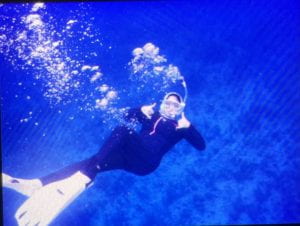Our day started our with our first journey to the Fore Reef (outer reef)! The stony corals there are much bigger and seem for the most part healthier (although there is still some disease). We swam through a bunch of harmless ctenophores (similar to jelly fish) that Phoenix identified as Comb Jellies. They have a distinctive jelly feel and appearance with a translucent color which made it difficult to capture on camera! It was super cute! Michael also spotted a loggerhead sea turtle! The Fore Reed was a little rough so we headed back to Middle Caye.
There we started our data collection of all sorts of trash that has been collecting on the atoll. From Nate’s presentation, we learned that there is a gyre in the Gulf between Belize and Honduras that collects a lot of trash that will wash up on the shore and harm the environment and wildlife. After some hard thinking, we decided to research the percentage of trash that could be properly disposed of and destroyed on island. We predicted that > 50% of the trash we collected could be disposable and split into groups. My group went to the coral cemetery and there was so much trash here. The heart breaking part of picking up trash is when the trash was so brittle that it would break and make more microplastics. Nate found a perfectly preserved- mummified box fish skeleton which was so incredible! I’ve never seen something so well preserved! The fish even had teeth! SO FLIPPING COOL!
Once all the groups were back from collecting our trash we discovered that Middle Caye did not have the resources to take recycle plastics or take them to the mainland regularly, and that they burn all plastics so our hypothesis was sadly off in the fact that more than half of the trash we collected could be recycled and destroyed in a more ecofriendly manner. We can only bring a bag of glass and metal with us compared with the 6. In the future we decided to bring sacs instead of trash bags to collect the trash and it made us all much more aware of the trash we were generating on island.
Post trash sorting photo taken by McKenna!
I had my presentation on annelids and hydroids today. Michael and Sophia asked two important questions that I did not know the answers too so I did some research today to answer them.
- What eats these annelids on the reef?
Many worms are eaten by mostly many reef fishes such as wrasses or angelfish species.
- Why are Christmas tree worms so many different colors?
One article said that Christmas tree worms will often be in colors that match the reef around them, but I have seen worms that are colors that don’t match the reef around them. Another article says that the host coral can influence the color of worms and that the color of Christmas tree worms can be used to determine coral health.
Link: https://link.springer.com/chapter/10.1007/978-3-030-91924-5_15
Tonight at dinner, one of our wonderful guides, Ruth, taught us all about the history of Belize, the demography and mix of cultures present, and the many attractions of Belize! I am getting so excited to see more of Belize!
Peace and Love <3
~ Maegan







Ohhh now you’ve got me curious to learn more about Christmas tree worm color! What do you think the colors we’ve seen here might reflect?